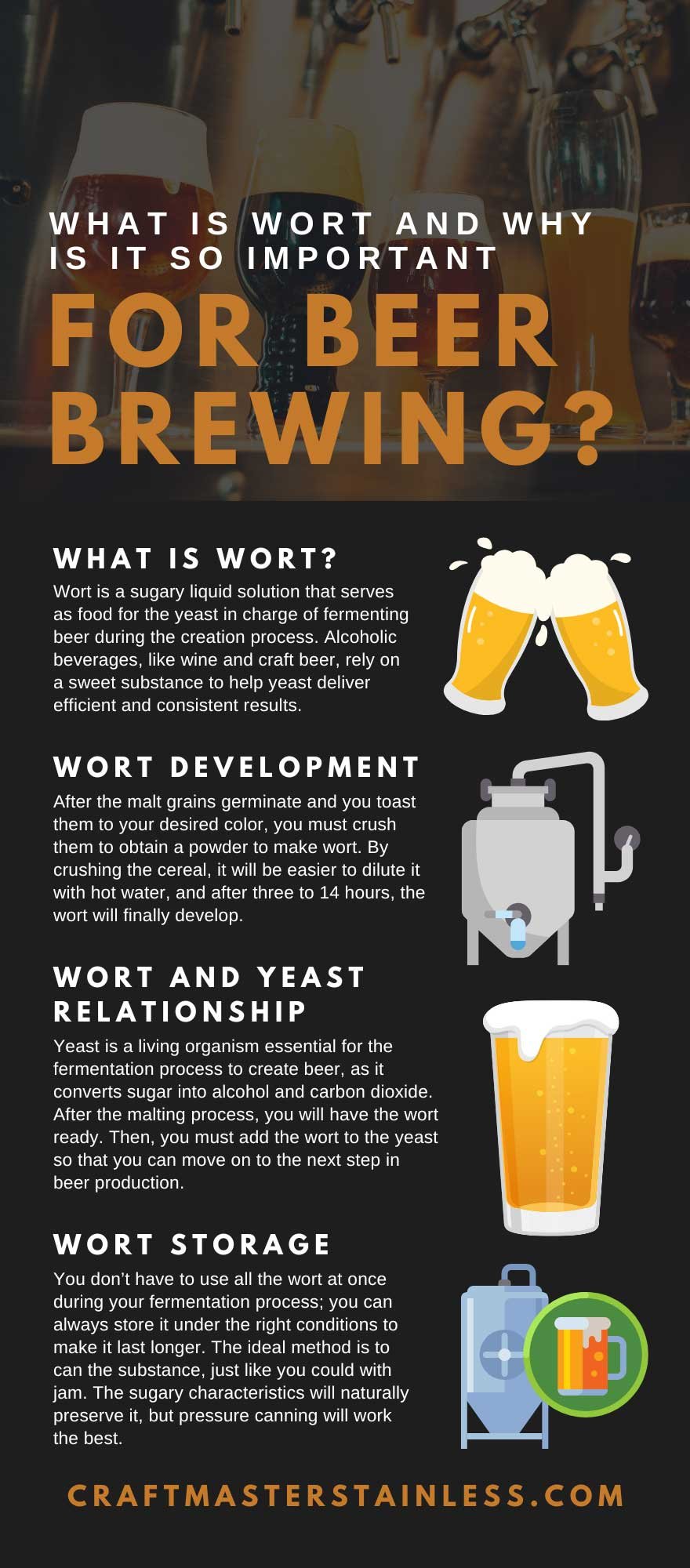What Is Wort and Why Is It So Important for Beer Brewing?
Starting a business requires knowledge, budget, and help from experienced people who can tell you how to get over the initial stages. A business like a brewery has unique features, especially with craft beer, because you need the beer to turn out.
A brewery must provide a unique experience to its customers. However, the brewing process must develop under the right conditions with the necessary equipment to ensure you avoid imperfections and use your time efficiently.
An element called wort is important for brewing beer for different reasons, and it’s one of the essential ingredients for developing the perfect craft. Wort is a part of the fermentation process, which is the most important aspect of brewing, so you must know how to use it.
What Is Wort?
Wort is a sugary liquid solution that serves as food for the yeast in charge of fermenting beer during the creation process. Alcoholic beverages, like wine and craft beer, rely on a sweet substance to help yeast deliver efficient and consistent results.
You may also hear this liquid referred to as a “beer starter.” This sugary liquid results from a mashing process combining crushed malts and hot water. You can create your own or buy a batch already premade, whichever’s easier for you. Plus, the wort lasts up to 12 months under the proper temperature conditions of 70 degrees. So if you don’t use it all, you don’t have to waste your product.
Malt Process
Brewers cultivate malt, a dry cereal grain, to extract their flavors and have a successful brewing process. These grains must germinate to release enzymes that will transform into a honey-like consistency when mixed with hot water.
Once the malts germinate, you can dry them to extract different flavors that you will then transfer to the final process to create beer. You can then toast the malt to give it new flavors. The malt will release a more bitter flavor the darker it becomes. A lighter-colored malt will produce a lighter-tasting beer.
This process takes between four to six days under the right conditions, like controlled temperature, moisture, and airflow. Equipment like a rotating container is necessary to prevent the grain from clumping, maintain a constant temperature, and enhance the smell.
Wort Development
After the malt grains germinate and you toast them to your desired color, you must crush them to obtain a powder to make wort. By crushing the cereal, it will be easier to dilute it with hot water, and after three to 14 hours, the wort will finally develop.
However, you must remove the leftover water to keep the wort from spoiling after a while. The right process will ensure the product you receive is of high quality, which is why you must pay special attention to times, temperature, and storage containers.
Adding Hops
Hops are another ingredient that will add flavor to the beer and make it as tasty as you want it to be. There are various hops, some of which can add a tropical flavor or a fresh scent.
Hops are another type of grain that grows mostly in the northwest part of the US in Oregon. The different types provide unique characteristics that you can enhance during the brewing process to add a special flavor to your craft beer.
Wort and Yeast Relationship
Yeast is a living organism essential for the fermentation process to create beer, as it converts sugar into alcohol and carbon dioxide. After the malting process, you will have the wort ready. Then, you must add the wort to the yeast so that you can move on to the next step in beer production.
Yeast is one of the main elements in the alcohol business because it turns sugar into alcohol and provides unique characteristics, like bubbles in beer and sparkling wine. Yeast is essential for making alcohol, and wort plays a crucial role in making that happen.
Clean Fermentation
For the fermentation process to deliver optimal results, it’s essential to have the necessary equipment that will prevent contamination from happening and ruining the process. A yeast storage tank is a perfect solution for clean fermentation that will maintain a constant temperature and flow.
Stainless steel containers have unique properties that provide the ideal environment for the fermentation process. They are durable, resistant, and hypoallergenic, and you don’t risk contamination that can cause unwanted flavors or characteristics in your beer.
Wort Storage
You don’t have to use all the wort at once during your fermentation process; you can always store it under the right conditions to make it last longer. The ideal method is to can the substance, just like you could with jam. The sugary characteristics will naturally preserve it, but pressure canning will work the best.
Another option you have is to freeze the remaining wort, but once you take it out, you must boil it before using it to avoid botulism. Wort is essential for beer brewing, so you don’t want to dispose of any that you could use later for your next brewing project.
Industrial Containers
Industrial containers are the best for maintaining a consistent workflow because they can hold up to 14 gallons of liquid. This large storage capacity makes them deliver the best results for your brewery. Better known as “unitanks,” these containers have essential properties for the fermentation and brewing process. The quantity and quality of your product will determine the size and usage you require for a storage tank. So ensure you consider what size you need for your container before purchasing one. Otherwise, you may come up short.
Beer Brewing Process
The beer brewing process is unique, and to be successful, you need the help of various products and ingredients. The brewing process begins with the mashing of malt grains that transforms them into wort, to which you add yeast to aid in the fermentation process.
With the right equipment and with time, yeast will transform the sweet wort into alcohol with bubbles, which gives beer its unique consistency. You must keep the fermentation process at a cold temperature, which you can achieve with the right storage tanks. And after this, the beer is ready for you to transfer into bottles.


